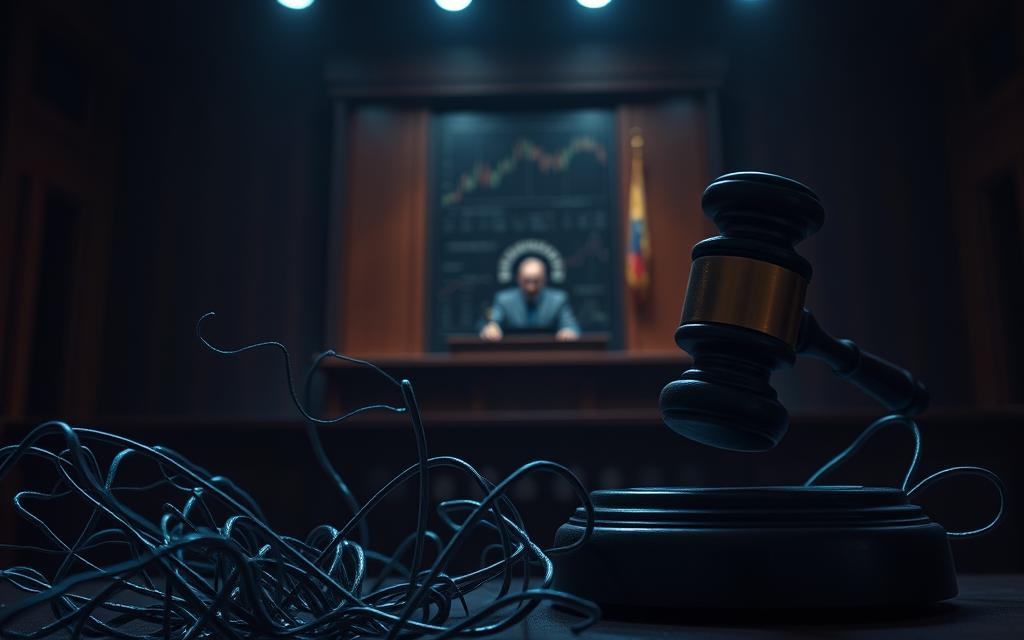Table of Contents
Investors in the cryptocurrency space often face risks beyond market volatility. One of the most damaging threats involves fraudulent schemes where developers vanish with funds, leaving behind worthless tokens. This deceptive tactic has become alarmingly common.
These scams, frequently seen in decentralized finance (DeFi) and NFT projects, exploit trust for financial gain. Victims suffer significant losses, with some cases exceeding billions. For example, OneCoin and Thodex exit scams drained over $6 billion combined.
Education is crucial to identify red flags before committing capital. Recognizing suspicious patterns helps avoid falling prey to such fraud. Vigilance and research remain an investor’s best defense.
Understanding What Is a Rug Pull in Crypto
The term rug pull reflects a brutal reality for many blockchain enthusiasts. Developers abandon projects abruptly, draining liquidity and leaving tokens worthless. This scam thrives in decentralized ecosystems where transparency is often lacking.
Definition and Origin of the Term
Rug pulls involve creators hyping a project, attracting investor funds, then disappearing. The phrase originated during the 2017 ICO boom, where fake startups collapsed after fundraising. Today, DeFi platforms face similar threats.
Key mechanics include:
- Pumping token prices through fake partnerships.
- Locking liquidity pools to prevent selling.
- Exploiting smart contract loopholes.
How Rug Pulls Impact Investors
Victims suffer immediate financial losses and long-term distrust. In 2023 alone, $2.8 billion vanished through DeFi exploits. The Squid Game Token collapse demonstrated how quickly value can evaporate—plummeting 99.99% after developers disabled sell functions.
| Type | Impact | Example |
|---|---|---|
| Hard Pull | Total fund withdrawal | OneCoin |
| Soft Pull | Gradual value erosion | Thodex |
Psychological scars often outweigh monetary damage. Many investors abandon cryptocurrency entirely after such scams. Vigilance and due diligence are critical to avoiding these traps.
Common Types of Rug Pull Scams
Fraudulent schemes plague the crypto industry, with rug pulls ranking among the most devastating. These scams exploit investor enthusiasm, vanishing with funds while leaving behind worthless assets. Below are the most prevalent tactics used by malicious actors.
Fake Coin Launches and ICOs
Fraudsters create hype around nonexistent projects, often using fake endorsements. The “ElonMars” token, for instance, used AI-generated celebrity videos to lure investors before collapsing. Red flags include:
- Unverifiable team members or partnerships.
- Overpromised returns with no technical whitepaper.
Exit Scams in Cryptocurrency
Platforms like Thodex orchestrate exit scams by faking technical issues. In 2021, its CEO vanished with $2 billion after claiming “maintenance.” These scams thrive on centralized platforms where founders control user funds.
Yield Farming and DeFi Rug Pulls
DeFi platforms lure users with high-yield promises but often lack audits. AnubisDAO drained $60 million by manipulating governance votes. Unaudited smart contracts and anonymous teams are major risk factors.
Ponzi Schemes in Crypto
Ponzi schemes like Forsage promised 1,000% APY but collapsed after amassing $340 million. They rely on new investor money to pay earlier participants—a unsustainable model doomed to fail.
Hard Rug Pulls vs. Soft Rug Pulls
Two distinct methods dominate crypto fraud: sudden collapses and prolonged deception. While both drain investor funds, their execution and visibility differ drastically. Understanding these tactics helps spot risks early.

Characteristics of Hard Rug Pulls
Hard pulls strike like lightning. Developers remove all liquidity instantly, crashing token values to zero. Uranium Finance exemplifies this—$50 million vanished in minutes after a smart contract exploit.
Common red flags include:
- Locked trading functions (e.g., Squid Game Token).
- Anonymous teams with fake LinkedIn profiles.
- Unaudited contracts labeled as “community-driven.”
How Soft Rug Pulls Unfold
Soft pulls are slow poison. Founders quietly sell holdings while maintaining social media hype. Libra Token used this tactic, bleeding funds over months before shutting down.
These scams mimic legitimate project struggles, making detection harder. Warning signs:
- Delayed roadmap updates or GitHub inactivity.
- Inflated “partnership” announcements without proof.
- Gradual price declines masked as market volatility.
| Feature | Hard Pull | Soft Pull |
|---|---|---|
| Speed | Instant (hours) | Gradual (months) |
| Liquidity | Fully drained | Partially siphoned |
| Example | Uranium Finance | BitConnect |
“Soft rug pulls are deadlier—they destroy trust in the entire ecosystem, not just one project.”
Can Rug Pulls Happen with NFTs?
NFTs have revolutionized digital ownership, but scams lurk behind the hype. Fraudsters exploit the excitement around unique tokens, leaving investors with worthless assets. From fake collections to rigged marketplaces, these schemes mirror traditional crypto fraud—with a digital art twist.
Fake NFT Projects
Fraudulent creators often launch fake NFT projects using stolen artwork or deepfaked endorsements. The “MetaStars” collection, for example, promoted AI-generated celebrity images before vanishing. Evolved Apes developers absconded with $2.7 million, abandoning promised game development.
Red flags to watch for:
- Unverified artist identities or plagiarized designs.
- Overblown rarity claims without blockchain proof.
- Anonymous teams avoiding public audits.
NFT Marketplace Exit Scams
Even trusted platforms can collapse. FTX’s NFT marketplace froze withdrawals before its bankruptcy, stranding users. Wash trading—where scammers inflate price through fake trading—also distorts market health.
Protect yourself by:
- Cross-checking NFT metadata on Etherscan.
- Researching marketplace liquidity and withdrawal policies.
“NFT scams thrive on FOMO—always verify before you buy.”
Are Rug Pull Scams Illegal?
Legal consequences for fraudulent crypto activities are becoming more severe. While no laws explicitly label these schemes as “rug pulls,” existing financial statutes apply. The SEC and DOJ increasingly target deceptive projects, treating them as securities fraud or wire fraud.

Legal Implications in the United States
The U.S. leverages the Howey Test to classify tokens as securities. In 2023, the DOJ indicted Frosties NFT founders for wire fraud and money laundering. Similarly, BitConnect promoters faced SEC charges for operating an unregistered securities offering.
Key precedents:
- The Ripple Labs case clarified token classification, affecting fraud charges.
- SBF’s conviction set a benchmark for prosecuting DeFi scams.
Regulatory Challenges in Crypto
Jurisdictional gaps complicate enforcement. Offshore exchanges like Thodex evade U.S. laws, leaving victims with losses and no recourse. The FATF’s Travel Rule struggles to monitor decentralized platforms.
| Factor | U.S. Jurisdiction | Offshore Exchanges |
|---|---|---|
| Asset Recovery | Possible via SEC/DOJ | Rarely achievable |
| Legal Penalties | Fines, imprisonment | Minimal consequences |
| Example | BitConnect | Thodex |
“Without global coordination, crypto fraud will exploit regulatory loopholes.”
New York attempted to criminalize rug pulls in 2022, but the bill failed. For now, legal consequences of crypto scams depend on existing frameworks.
How to Detect and Avoid Rug Pulls
Smart investors recognize that prevention beats recovery in crypto markets. By mastering detection tactics, you can sidestep fraudulent schemes before they unravel. Vigilance and verified data are your strongest allies.

Conducting Thorough Research
Start with blockchain explorers like Etherscan. Check liquidity locks and holder distribution—concentrated ownership often signals risk. A shocking 94% of rugged projects lacked KYC, per industry reports.
Key tools:
- CertiK or Hacken audits: Verify third-party reviews.
- Social media cross-checks: Fake endorsements crumble under scrutiny.
- GitHub activity: Inactive repos hint at abandoned development.
Verifying Team and Community Engagement
Anonymous founders should raise immediate red flags. Cross-check LinkedIn profiles for past project success. Authentic Telegram groups debate ideas; bot-filled ones spam moon emojis.
Warning signs:
- Overlapping team photos across multiple projects.
- Vague whitepapers without technical depth.
Checking Tokenomics and Smart Contracts
Unfair presales with 40%+ team allocations often precede collapses. Unaudited or “self-audited” contracts are ticking time bombs. Use this table to compare research platforms:
| Tool | Focus | Best For |
|---|---|---|
| Etherscan | Contract verification | Smart contracts |
| DeFiLlama | Liquidity metrics | Tokenomics |
| CertiK Skynet | Security scores | Audits |
“Assume every project is guilty until proven innocent—dyor is non-negotiable.”
Notable Rug Pull Examples in Crypto History
History reveals devastating losses from deceptive crypto schemes. These cases expose vulnerabilities in the space, teaching investors hard lessons. Below are landmark scams that reshaped regulatory approaches.

OneCoin: The Billion-Dollar Scam
OneCoin defrauded investors of $4 billion through a fake blockchain. Founder Ruja Ignatova promoted a global MLM structure, claiming proprietary technology. No blockchain existed—transactions were logged on private servers.
Key tactics:
- Fake educational packages sold as “mining licenses.”
- Staged conferences with paid actors posing as satisfied users.
- Zero verifiable transactions on public ledgers.
Squid Game Token and Other High-Profile Cases
Squid Game Token collapsed after a 100,000% price surge. Developers coded a backdoor, disabling sell functions post-launch. Investors watched helplessly as values plummeted to zero.
Other notorious examples:
- AnubisDAO: Fake governance votes drained $60 million from liquidity pools.
- Frosties NFT: First NFT rug pull indicted by the DOJ in 2023 ($1.3M stolen).
| Case | Losses | Method |
|---|---|---|
| OneCoin | $4B | Fake blockchain |
| Squid Game Token | $3.3M | Sell-function lock |
| AnubisDAO | $60M | Governance exploit |
“Scammers innovate faster than regulations—vigilance is the only shield.”
These cases spurred SEC crackdowns on unregistered securities. Projects now face stricter KYC requirements and audit mandates. Yet, new schemes emerge, demanding constant investor education.
Conclusion: Staying Safe in the Crypto Space
Protecting assets requires constant vigilance in decentralized markets. Audited projects and transparent teams reduce risks significantly. Skepticism toward unrealistic returns prevents most losses.
Diversify holdings—allocate under 5% to speculative tokens. The Lummis-Gillibrand bill proposes stricter DeFi oversight, benefiting the entire community. Remember, 73% of new tokens fail within months.
Use tools like CoinMarketCap’s scam dashboard before trading. Verify smart contracts, check liquidity locks, and track developer activity. Your money’s safety depends on these steps.
Stay informed, stay cautious, and preserve your portfolio’s value. The right habits separate successful investors from scam victims.
FAQ
How do rug pulls affect cryptocurrency investors?
Rug pulls drain liquidity or abandon projects, leaving investors with worthless tokens. Scammers vanish with funds, causing severe financial losses.
What are the main types of rug pull scams?
Common schemes include fake ICOs, exit scams, DeFi yield farming frauds, and Ponzi schemes. Each manipulates trust for illicit gains.
What’s the difference between hard and soft rug pulls?
Hard rug pulls involve sudden fund theft, while soft pulls slowly devalue tokens through misleading actions like hidden sell-offs.
Can NFTs be involved in rug pulls?
Yes. Fake NFT projects or marketplace exit scams occur when creators abandon platforms after collecting investor money.
Are rug pulls illegal under U.S. law?
Yes. Authorities prosecute fraudulent schemes under securities fraud, wire fraud, or anti-money laundering statutes.
How can investors spot potential rug pulls?
Research teams, audit smart contracts, and monitor community engagement. Red flags include anonymous developers and unrealistic returns.
What are some infamous rug pull cases?
OneCoin and Squid Game Token scams defrauded billions. These highlight risks in unverified crypto projects.









